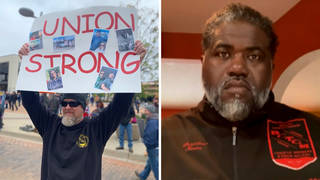
Guests
- Jack Templepolicy analyst at the National Employment Law Project. He’s the author of the new report, “Super-Sizing Public Costs: How Low Wages at Top Fast-Food Chains Leave Taxpayers Footing the Bill.”
New research shows more than half of low-wage workers at fast-food restaurants rely on public assistance to survive – a rate double that of the overall workforce. According to researchers at the University of California, Berkeley, low wages in the fast-food industry cost American taxpayers nearly $7 billion every year – that’s more than the entire annual budget of the Centers for Disease Control and Prevention. A companion report by the National Employment Law Project found McDonald’s alone costs Americans $1.2 billion annually by paying its workers insufficient wages. Last year the top 10 largest fast-food companies alone made more than $7.4 billion in profits.
Transcript
JUAN GONZÁLEZ: A Big Mac costs only a couple dollars, but it comes with a $7 billion side of welfare. New research shows more than half of low-wage workers at fast-food restaurants rely on public assistance to survive—a rate double that of the overall workforce. According to researchers at the University of California, Berkeley, low wages in the fast-food industry cost American taxpayers nearly $7 billion every year. That’s more than the entire annual budget of the Centers for Disease Control and Prevention. A companion report by the National Employment Law Project found McDonald’s alone costs American taxpayers $1.2 billion annually by paying its workers insufficient wages. Last year, the top 10 largest fast-food companies alone made more than $7.4 billion in profits.
AMY GOODMAN: While CEOs are raking in record profits, in August fast-food workers went on strike in 60 U.S. cities in the largest protest of an almost year-long campaign to raise service-sector wages at restaurants, including McDonald’s and Burger King. The striking workers say they want to unionize without retaliation in order to collectively bargain for a $15-an-hour “living wage,” more than twice the federal minimum of $7.25. Longtime fast-food worker Shantel Walker went on strike in New York City.
SHANTEL WALKER: The truth, I’ve been in fast food since 1999, on and off, and it’s 2013. I had a couple other jobs in between. But for the most part, no matter what job I get, it always starts back at $7.25. That’s—like they say, that’s state minimum wage. So, it doesn’t matter where you work. That’s the whole irony of this whole situation. It’s not just fast food. It’s people in factories. It’s people in warehouses. It’s people all over. They’re not making money. Some people can’t even pay their rent. Some people have—some people live in shelters. I know some people that don’t even have homes to live in. They live in shelters, and they work every day. That’s what you call the working poor.
AMY GOODMAN: Well, for more, we go to Washington, D.C., where we’re joined by Jack Temple, policy analyst at the National Employment Law Project, author of this new report, “Super-Sizing Public Costs: How Low Wages at Top Fast-Food Chains Leave Taxpayers Footing the Bill.”
Jack Temple, welcome to Democracy Now! Lay out your major findings.
JACK TEMPLE: Thanks so much.
You know, I think this report is an important contribution to what we’ve seen over the last year. You know, we know that the fast-food industry pays low wages. But what this report clarifies is that whether or not you work in the fast-food industry, whether or not you eat fast food, the low-wage business model in the fast-food industry is costing you money. The low-wage business model, which forces workers in the industry to rely on public assistance in order to afford food or healthcare or housing or other basic necessities, is draining the economy of resources. And so, this is an industry that’s really a race to the bottom. And it’s not just spelling economic hardship for workers in the industry; it’s spelling, yeah, weak economic growth and really dragging down the economy across the board.
JUAN GONZÁLEZ: Jack, I wanted to ask you about some of the arguments that are used in terms of defending this practice. One is that many of these restaurants, especially McDonald’s and Burger Kings, are franchises, where basically every restaurant is a small business, in effect, and that these jobs are entry-level jobs that naturally would pay low wages, because the people would move on to other jobs.
JACK TEMPLE: Mm-hmm. Well, the facts refute both of those arguments, actually, so let’s just take them both in turn.
For all the talk about small businesses in this industry, as you mentioned in the opening, you know, McDonald’s made $5.5 billion last year. This is an industry that’s making hundreds of billions of dollars every year. And the corporate level really does exercise a lot of control over franchisees. You know, the food tastes the same in any McDonald’s you walk into. The napkins look the same. Whenever there’s a new menu item, all the franchisees have to comply. They have to buy new equipment, when it’s needed. It’s not really fair for the company to say that they can dictate the terms of basically every facet of the arrangement between the corporation and the franchisee, but all of the sudden they have no control over wages. They determine the costs. They determine the requirements that franchisees have to comply by. And, in effect, they absolutely control the wages. And so, the corporations are really on the hook for wages in this industry. And, you know, the only thing more outrageous than that is the fact that they have substantial profits at the same time.
And regarding the question about entry-level workers, the data really show that this is an industry that is significantly older and more experienced than maybe what popular impression might suggest. So, 70 percent of all fast-food workers are adults over the age of 20. And 30 percent, nearly a third, of those workers are actually supporting children at home. And so, these low wages are being used to support adults that are trying to make ends meet, support families that are trying to make ends meet. And that’s why you see the public cost of this industry so high. These wages just aren’t cutting it for workers, and they’re requiring public assistance in order to make ends meet.
AMY GOODMAN: How much do these franchises make annually? How much do the CEOs make? How much do the workers make? And talk about justifying the disparity.
JACK TEMPLE: Yeah, so, that’s a perfect contrast for you. So, at the seven largest publicly traded fast-food companies in the U.S., the CEOs at those companies made a combined total of $53 million in annual compensation last year. At McDonald’s, just for example, the CEO, Don Thompson, made $13.7 million alone last year. Meanwhile, the median hourly wage for a fast-food worker is $8.69 an hour. It’s one of the lowest wages in the economy today for the occupation. So you see the stunning disparity between what the workers are making in this industry and what the CEOs are making.
AMY GOODMAN: The demographic of the workers?
JACK TEMPLE: Yeah, I mean, you know, these are workers, as I mentioned, that are significantly older than we expect. The median age of the fast-food worker is nearly 29 years old. Many are supporting children. So, you know, this is a workforce that actually isn’t all that different than what we’re seeing across the economy now. Low-wage jobs have made up the majority of job growth throughout the post-recession recovery. And we’ve seen over the last several decades a real shift in the economy away from the manufacturing jobs, the industrial jobs, that once supported the middle class throughout the beginning and the middle of the 20th century, to a service economy in retail and restaurants. These are the industries that are beginning to define the core of the American economy today. And that’s a problem because these are the industries that are driving low wages for a lot of Americans.
JUAN GONZÁLEZ: Not only are they defining the core of the economy, the bulk of the jobs created since the Great Recession of 2008 have been in these kinds of low-wage jobs. Can you talk about what that means for the future of our economy?
JACK TEMPLE: Yeah, I think it means two things. The first point, it means, at the very least, more Americans are going to be finding themselves stuck in low-wage jobs. The more low-wage jobs dominate the economy, the more Americans are going to find themselves relying on low-wage jobs to make ends meet. And the data bear that out. So, the Bureau of Labor Statistics does projections for job growth over the next decade and finds that six of the 10 largest growth occupations over the next decade are going to be low-wage occupations. And so, this is an economic trend that’s been going on for the last three decades and is projected to continue. We know that if we don’t take active steps to raise wages, the economy is not going to be doing it on its own.
I think the other—obviously, the real cost of this is, even if you’re not someone that ends up relying on low-wage jobs, you know, as we show in this report, the low-wage economy, low-wage industry, is costing all of us, though. The more workers have to rely on public assistance in order to make ends meet, that’s more money drained out of the economy and going to support massively profitable industries and companies.
AMY GOODMAN: In August, New York City Councilmember Letitia James expressed support for striking fast-food workers and talked about the feminization of poverty.
COUNCILMEMBER LETITIA JAMES: Most of the individuals who work in fast-food restaurants, which is one of the growing—fastest-growing industries in the City of New York, it’s a race to the bottom. A significant number of them in retail and in the fast-food restaurants are women of color who look like me. And so, there is a feminization of poverty. It’s a term which describes most women who live below the poverty level who are struggling to make ends meet.
AMY GOODMAN: That’s New York City Councilmember Letitia James, who’s running for public advocate here in New York. If—Jack Temple, the issue of this particularly affecting women, that welfare is a women’s issue, and what you think the public should do about this?
JACK TEMPLE: Well, you know, I mean, I think we hear that argument a lot, you know, when we’re talking about public assistance, generally, or talking about the American safety net. I think, you know, what the trends show, at least, is that what we might have been able to argue affects only a small amount of the population is beginning to affect workers across the board, across the economy. You know, it’s going to be the case where we’re not able to talk about specific demographics or specific qualities. This low-wage job growth is going to begin to affect all of us, the more the current trends continue.
And so, I think, you know, as you mentioned in the beginning of the segment, a lot of opponents or a lot of the company spokespersons will argue that these low-wage jobs are exclusively teens or exclusively, you know, workers that are starting out or entry-level workers, and that provides a springboard for more opportunity. But the fact of the matter is, these low-wage jobs are beginning to affect all Americans across the board. If they’re not relying on low-wage jobs already, then their tax dollars are supporting low-wage companies. And so, it’s beginning to be a core—an aspect of the core of the American economy.
AMY GOODMAN: And finally, five seconds: the argument the companies make, “Then we’ll have to pick up the costs of the food, and that will particularly hurt poorer people.”
JACK TEMPLE: Well, companies have a ton of resources. We’re talking, again, about a multibillion-dollar—
AMY GOODMAN: Five seconds.
JACK TEMPLE: —multibillion-dollar industry here. There’s just no reason to suspect that companies can’t afford higher wages.
AMY GOODMAN: Jack Temple, we want to thank you for being with us, with the National Employment Law Project. We’ll link to your report, “Super-Sizing Public Costs.”












Media Options